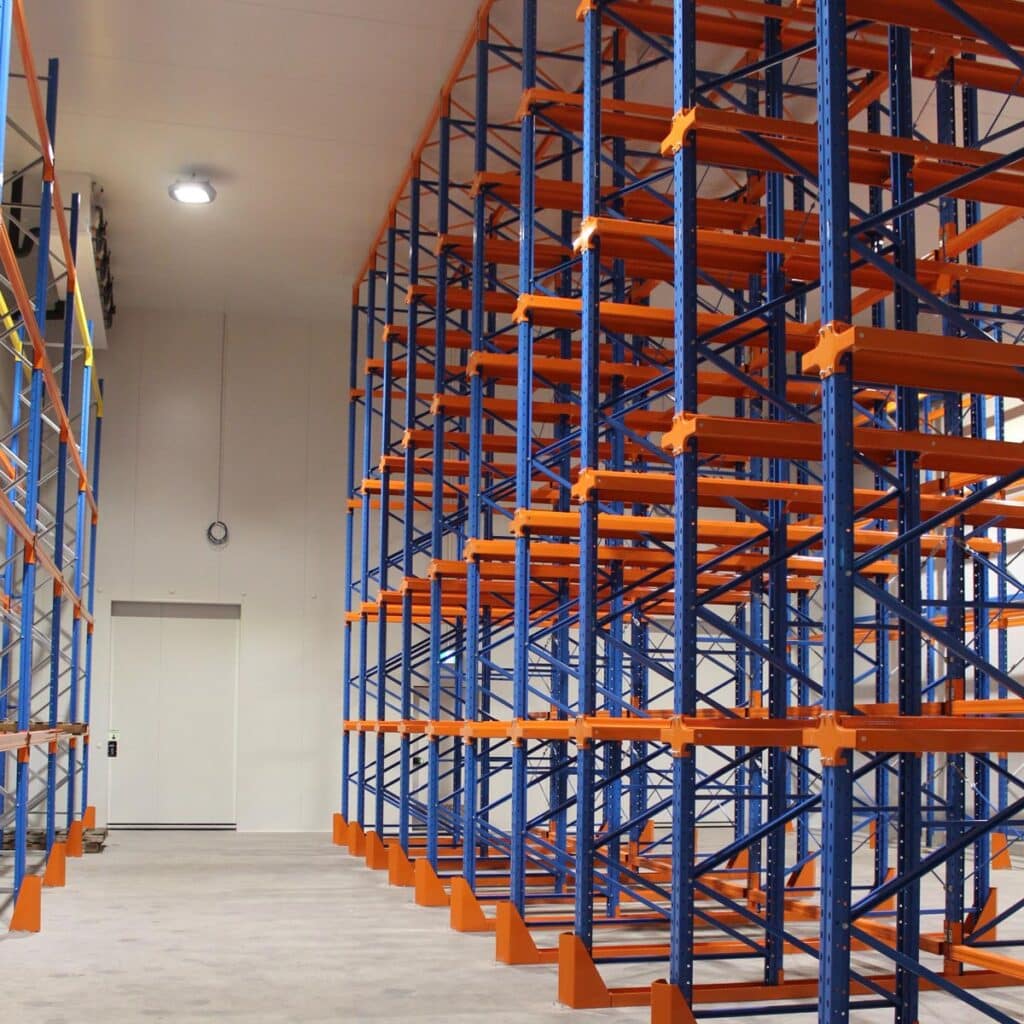Heavy duty pallet racks are essential elements in contemporary warehouse and industrial storage systems. These durable and sturdy racks are specifically designed to handle large loads and provide efficient storage solutions for heavy items. This article explores the benefits and applications of heavy-duty racks, emphasizing their significance in optimizing warehouse operations and maximizing storage space.
The Advantages and Uses of Heavy-Duty Pallet Racks
- Increased Load Capacity:
One of the primary advantages of heavy-duty pallet racks lies in their exceptional load-bearing capacity. These racks are engineered to withstand heavy loads, typically ranging from 500 kilograms to 2000 kilograms per level. Constructed with robust materials and sturdy construction, they ensure reliable and secure storage for substantial items, such as automotive parts, machinery components, industrial equipment, raw materials, or food inventory.
- Enhanced Durability and Safety:
Heavy-duty pallet racks are built to be long-lasting. Constructed using high-quality steel or other durable materials, they exhibit resistance to wear, impact, and deformation. The structural integrity of these racks minimizes the risk of rack failure or collapse, ensuring a safe working environment. Additionally, safety features like beam connectors, locking pins, and load stoppers further enhance the stability and security of the stored items.
- Versatile Configuration:
Heavy-duty pallet racks offer versatility in terms of configuration and adaptability to diverse storage needs. They can be customized to accommodate different pallet sizes, shapes, and weights. The racks can be adjusted in height, width, and depth to maximize vertical and horizontal space within the warehouse. This flexibility enables efficient utilization of the storage area and easy reconfiguration to meet changing inventory requirements.
- Accessibility and Selectivity:
Despite the nature of heavy-duty pallet racks, these racks provide excellent accessibility and selectivity. Forklifts and other material handling equipment can easily maneuver within the aisles to load and unload pallets. The pallet racking system allows operators to directly access any pallet without moving others, ensuring efficient order picking, inventory rotation, and rapid response to customer demands.
- Space Optimization:
By employing heavy-duty pallet racks, warehouses can optimize storage space and maximize capacity. The vertical design of the pallet racking system enables efficient utilization of overhead space, particularly in facilities with high ceilings. This vertical storage approach reduces the required floor footprint, freeing up space for other operations like assembly, packaging, or additional storage systems.
- Improved Inventory Management:
Heavy-duty pallet racks contribute to streamlined inventory management. The organized and accessible storage they provide facilitates inventory tracking, stock rotation, and efficient order fulfillment processes. Implementation of labeling or barcode systems enables accurate monitoring of stock levels, and item tracking, and ensures inventory accuracy.
- Seamless Integration:
Heavy-duty pallet racks can seamlessly integrate with other warehouse equipment and technologies. They can be combined with conveyors, automated storage and retrieval systems (AS/RS), or different pallet racking systems to create comprehensive material handling solutions. This integration enhances operational efficiency, reduces labor costs, and improves overall warehouse productivity.
What is a Heavy duty pallet racks rack used for?
Heavy duty pallet racks is used for the purpose of efficiently storing and organizing large, heavy, or bulky items in industrial and commercial settings. These racks are designed to handle substantial weight loads and are commonly used in warehouses, distribution centers, manufacturing facilities, and other storage environments. The primary functions and uses of Heavy duty pallet racks include:
Palletized Storage:
Heavy duty pallet racks are often employed for storing palletized goods. They provide a systematic and organized way to store large quantities of products on pallets.
Optimizing Vertical Space
These racks are designed to maximize vertical storage space, allowing businesses to make the most efficient use of their warehouse or storage facility.
Handling Heavy Loads:
The main purpose of Heavy duty pallet racks is to support and distribute the weight of large and heavy items. This makes them suitable for storing items such as machinery parts, automotive components, construction materials, and more.
Selective Storage:
In selective pallet racking systems, each pallet position is directly accessible. This enables quick and easy retrieval of specific items without the need to move other stored goods.
Customizable Configurations:
Heavy duty pallet racks often have adjustable beam levels, allowing for customization based on the size and dimensions of the stored items. This adaptability makes them suitable for a wide range of products.
Warehouse Organization:
Heavy duty racks contribute to a more organized warehouse environment, facilitating efficient inventory management and order fulfillment processes.
Variety of Industries:
Heavy-duty pallet racks are used across various industries, including automotive, manufacturing, retail, pharmaceuticals, and more. They are versatile and can accommodate the diverse storage needs of different sectors.
Safety and Durability:
These racks are constructed from durable materials such as steel to ensure stability and safety. They often include safety features such as column protectors and safety locks.
Bulk Storage:
Businesses dealing with large quantities of products, raw materials, or finished goods often utilize Heavy-duty pallet racks for bulk storage.
Efficient Inventory Management:
The use of Heavy duty pallet racks allows for efficient tracking and management of inventory, enabling businesses to maintain accurate stock levels and streamline their logistics processes.
In summary, Heavy-duty racks play a crucial role in the logistics and storage operations of businesses by providing a robust and organized solution for handling large and heavy items. They contribute to space optimization, safety, and overall efficiency in warehouse management.
How much does it cost to rack a pallet?
The cost to rack a pallet, referring to the cost of pallet racking systems or storage solutions for a single pallet position in a warehouse, can vary significantly based on several factors. These factors include the type of pallet racking system, the size of the storage facility, the level of customization needed, and the region or country where the installation takes place. Here are some key considerations affecting the cost:
- Type of Pallet Racking:
Different types of pallet racking systems have varying costs. Selective pallet racking is generally less expensive than more complex systems like drive-in/drive-through racking or automated storage and retrieval systems (AS/RS).
- Size and Configuration:
The overall size and configuration of the pallet racking system, including the number of bays, levels, and the height of the racks, will impact the cost. Larger and more complex systems will generally incur higher costs.
- Materials and Construction:
The materials used in the construction of the pallet racking, such as the type of steel, will influence the cost. Heavy-duty racks made of high-quality materials are likely to have a higher price tag.
- Customization:
Customized features, such as adjustable beam levels, special load-bearing requirements, or additional safety features, can increase the overall cost.
- Installation Costs:
The cost of professional installation services should be factored into the overall expense. Complex installations may require more labor and time, impacting the installation cost.
- Accessories and Safety Features:
The inclusion of accessories such as wire decking, pallet support bars, safety locks, and other safety features will contribute to the overall cost.
- Location:
The cost can vary based on the region or country where the installation takes place due to factors such as local labor rates, building codes, and logistics.
- Supplier and Brand:
Different suppliers and brands may offer pallet racking solutions at varying price points. Established and reputable suppliers may command higher prices.
To get an accurate estimate for the cost of racking a pallet in a specific context, it’s advisable to consult with professional pallet racking suppliers or manufacturers. They can assess the specific requirements of your facility, provide recommendations, and offer cost estimates based on your needs. Keep in mind that the cost will also include considerations for ongoing maintenance and potential future expansions or modifications to the racking system.
Contact us and ask our engineers to give you a free visit to your site for consultation.
Email: metalegypt@hotmail.org

